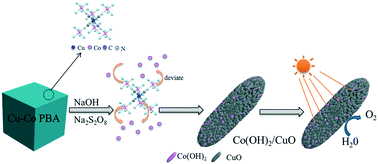Efficient difunctional photocatalyst prepared in situ from Prussian blue analogues for catalytic water oxidation and visible-light absorption†
Abstract
The photocatalytic water oxidation reaction (WOR) usually requires the use of a noble metal catalyst as well as a photosensitizer, therefore developing new types of non-noble metal and photosensitizer-free catalysts is of great significience for the photocatalytic WOR. In this paper, a facile paradigm for designing photosensitizer-free difunctional catalysts from old fashioned cubic MOFs as Prussian blue analogues (PBAs) is presented. The as-prepared Co(OH)2-modified CuO (Co(OH)2/CuO) nanoparticles displayed robust catalytic efficiency (3567 μmol h−1 g−1) toward visible-light-driven water oxidation reaction (WOR). Intriguingly, insights into the WOR pathway indicated that the Co(OH)2/CuO nanoparticles could serve as both water oxidation catalysts and visible light absorption centers and they still showed photocatalytic performance under monochromatic light at 765 nm and maintained 64.2% oxygen evolution compared to the case with light cutting off at 420 nm. The Co(OH)2/CuO nanoparticles were shown to be quite stable in the reaction system via characterizing their properties before and after the reactions. While the synergetic effect between Co(OH)2 and the CuO clusters was found to be key to the abnormal photocatalytic activity of this catalyst in the complicated WOR process. We hope that this contribution will serve as a useful template for other researchers to design new transition metal catalysts for WOR.



 Please wait while we load your content...
Please wait while we load your content...